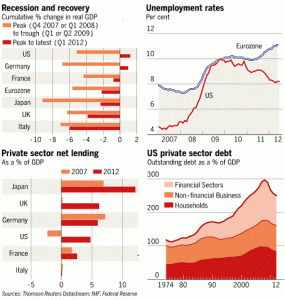In Monday’s Financial Times, economics editor Martin Wolf explains why the “end” will not be soon. He notes that it has been almost five years since the beginning of our contemporary financial turmoil, if one marks such by the first major sign of sub-prime mortgage problems in the U.S. He characterizes the past five years as ones if which policies (both monetary and fiscal) have been very aggressive; yet economies – US, Europe and Japan – have been stagnant. David Levy describes such a situation as a “contained depression”; that is, these economies feature excessive leverage (debt), especially in household and financial sectors and expansionary macroeconomic policy. Stated differently, the private sector continues to de-leverage (reduce its debt level) while governments attempt to counter such counter-cyclical demand with public borrowing and money creation. The two have, in fact, been connected, as central banks purchase much of the newly created governmental debt. In short – remember the world of IS-LM – there is no crowding out. The charts below show the depth of the problem.
The lower right hand graph shows that private sector debt in the US has come off its peak (of 296% of GDP in 2008) by roughly 17% (250% of GDP) about where the economy was in 2003. If Reinhardt and Rogoff are correct, we have at least two more years to go, given that an “average” balance sheet recession last seven years. If the mid-1990s feature a stable debt to GDP ratio, of just under 200% of GDP, we are only half-way “home.” In terms of economic growth, clearly, the Eurozone has yet to recover; while, the US and Germany have just barely exceeded their previous GDP peak (in 2007) – see upper left graph.
According to Wolf,
We know that big financial crises cast long shadows, particularly in countries whose underlying rate of growth is modest, which makes de-leveraging slow. Policy must both sustain demand and facilitate de-leveraging. This means aggressive monetary and fiscal policies, working in combination, along with interventions aimed at recapitalising banks and accelerating restructuring of private debt.
Policies designed to bring down public debt prior to the end of private de-leveraging will dampen economic growth and extend the period of adjustment. Though public fiscal consolidation is necessary for long run stability, if it is not crafted to be consistent with an economic growth path that can meet the required debt service, economic stagnation or worse will be the order of the day.
Wolf concludes that
Far too much policy making and advice neither recognises the post-crisis challenges nor crafts effective answers. The heart of the matter is accelerating de-leveraging, while promoting recovery. By that standard, the policies now in place are, alas, very far from good enough.
